Summary
The impact of the subterranean herbivorous rodent Spalacopus cyanus Molina on the herbaceous vegetation was studied by comparing biomass, species richness and species diversity at the end of the growing season in areas with and without burrows in coastal arid Chile. Total biomass was 60% higher in areas with burrows. This difference was mainly due to the large increase of Mesembryanthemum cristallinum L., a succulent prostrate annual herb. Unexpectedly, bulb biomass of geophytes, eaten by Spalacopus, did not differ between areas. However, in areas with burrows bulbs of geophytes were more numerous and smaller. It is possible that burrowing activities facilitate the occurrence of new small bulbs through seed germination. Species composition and diversity did not differ greatly between areas. Burrowing activities by Spalacopus, the life cycle of Mesembryanthemum, and climate seem to be the most important factors determining species abundance and diversity of herbs in this system.
Similar content being viewed by others
References
Andersen DC (1987) Below-ground herbivory in natural communities: a review emphasizing fossorial animals. Q Rev Biol 62:261–286
Andersen DC, MacMahon JA (1981) Population dynamics and bioenergetics of a fossorial herbivore, Thomomys talpoides. Ecol Monogr 5:179–202
Andersen DC, MacMahon JA (1985) The effect of catastrophic ecosystem disturbance: the residual mammals at Mount St. Helens. J Mamm 66:581–589
Contreras LC (1986) Bioenergetics and distribution of fossorial Spalacopus cyanus (Rodentia). Physiol Zool 59:20–28
Contreras LC, Torres-Mura JC, Yañez JL (1987) Biogeography of octodontid rodents: an eco-evolutionary hypothesis. Fieldiana Zool (New series) 39:401–411
Ehrendorfer F (1976) Evolutionary significance of chromosomal differentiation patterns in gymnosperms and primitive angiosperms. In: Beck CB (ed) Origin and Early Evolution of Angiosperms. Columbia University Press, New York
Hickman G (1990) Adaptativeness of tunnel systems features in subterranean mammals. In: Nevo E, Reig OA (eds) Evolution of Subterranean Mammals at the Molecular and Individual Level, Wiley-Liss, New York, pp 185–210
Hobbs RJ, Mooney HA (1985) Community and population dynamics of serpentine grassland annuals in relation to gopher disturbance. Oecologia 67:342–351
Huntly NH, Inouye RS (1988) Effects of gophers (Geomys bursarius) on ecosystems. BioScience 38:786–793
Lovegrove BG, Jarvis JUM (1986) Coevolution between mole-rats (Bathyergidae) and a geophyte, Micranthus (Iridaceae). Cimbebasia 8:79–85
Nevo E (1979) Adaptive convergence and divergence of subterranean mammals. Ann Rev Ecol Syst 10:269–308
Paskoff R (1970) Recherches Géomorphologiques dans le Chili Semi Aride. Biscaye Frères Imprimeurs, Bordeaux, France
Reichmann OJ (1988) Comparison of the effects of crowding and pocket gopher disturbance on mortality, growth and seed production of Berteroa incana. Am Midl Nat 120:58–69
Reichman OJ, Jarvis JUM (1989) The influence of three sympatric species of fossorial mole-rats (Bathyergidae) on vegetation. J Mamm 70:763–771
Reig OA (1970) Ecological notes on the fossorial octodont rodent Spalacopus cyanus (Molina). J Mamm 51:592–601
Reig OA, Busch C, Ortells MO, Contreras JR (1990) An overview of evolution, systematics, population biology, cytogenetics, molecular biology and speciation in Ctenomys. In: Nevo E, Reig OA (eds) Evolution of Subterranean Mammals at the Molecular and Individual Level, Wiley-Liss, New York, pp 71–96
Thorne DH, Andersen DC (1990) Long-term soil-disturbance pattern by a pocket gopher, Geomys bursarius. J Mamm 71:84–89
Torres-Mura JC (1990) Uso del espacio por el roedor fosorial Spalacopus cyanus. Master Thesis, Facultad de Ciencias, Universidad de Chile
Vidiella PE, Armesto JJ (1989) Emergence of ephemeral plants species from soils samples of the Chilean coastal desert in response to experimental irrigation. Revista Chilena de Historia Natural 62:99–107
Vivrete NJ, Muller CH (1977) Mechanism of invasion and dominance of coastal grassland by Mesembryanthemum crystallinum. Ecol Monogr 47:301–318
Zoellner O (1972) El genero Leucocoryne. Anales Museo Historia Natural de Valparaiso. 5:9–81
Author information
Authors and Affiliations
Additional information
This is a contribution of the Program of Arid Zone Studies of Universidad de La Serena
Rights and permissions
About this article
Cite this article
Contreras, L.C., Gutiérrez, J.R. Effects of the subterranean herbivorous rodent Spalacopus cyanus on herbaceous vegetation in arid coastal Chile. Oecologia 87, 106–109 (1991). https://doi.org/10.1007/BF00323787
Received:
Accepted:
Issue Date:
DOI: https://doi.org/10.1007/BF00323787




